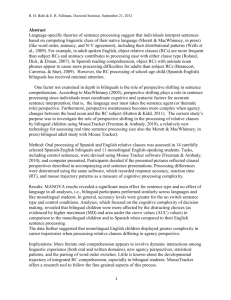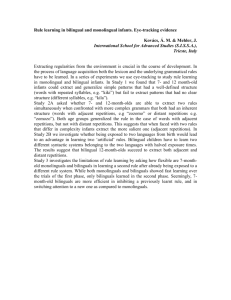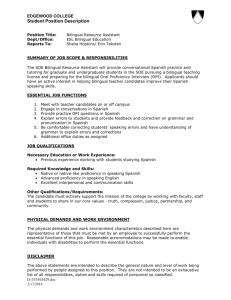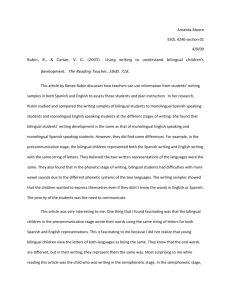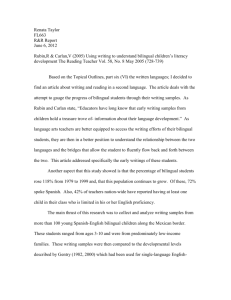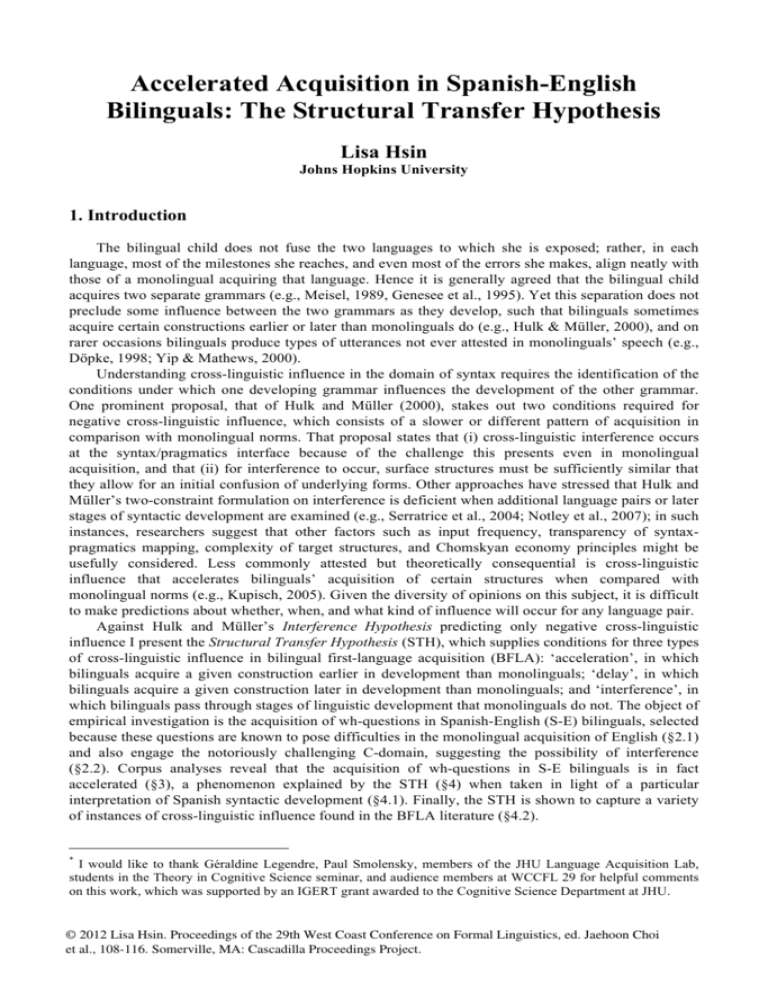
Accelerated Acquisition in Spanish-English
Bilinguals: The Structural Transfer Hypothesis
Lisa Hsin
Johns Hopkins University
1. Introduction*
The bilingual child does not fuse the two languages to which she is exposed; rather, in each
language, most of the milestones she reaches, and even most of the errors she makes, align neatly with
those of a monolingual acquiring that language. Hence it is generally agreed that the bilingual child
acquires two separate grammars (e.g., Meisel, 1989, Genesee et al., 1995). Yet this separation does not
preclude some influence between the two grammars as they develop, such that bilinguals sometimes
acquire certain constructions earlier or later than monolinguals do (e.g., Hulk & Müller, 2000), and on
rarer occasions bilinguals produce types of utterances not ever attested in monolinguals’ speech (e.g.,
Döpke, 1998; Yip & Mathews, 2000).
Understanding cross-linguistic influence in the domain of syntax requires the identification of the
conditions under which one developing grammar influences the development of the other grammar.
One prominent proposal, that of Hulk and Müller (2000), stakes out two conditions required for
negative cross-linguistic influence, which consists of a slower or different pattern of acquisition in
comparison with monolingual norms. That proposal states that (i) cross-linguistic interference occurs
at the syntax/pragmatics interface because of the challenge this presents even in monolingual
acquisition, and that (ii) for interference to occur, surface structures must be sufficiently similar that
they allow for an initial confusion of underlying forms. Other approaches have stressed that Hulk and
Müller’s two-constraint formulation on interference is deficient when additional language pairs or later
stages of syntactic development are examined (e.g., Serratrice et al., 2004; Notley et al., 2007); in such
instances, researchers suggest that other factors such as input frequency, transparency of syntaxpragmatics mapping, complexity of target structures, and Chomskyan economy principles might be
usefully considered. Less commonly attested but theoretically consequential is cross-linguistic
influence that accelerates bilinguals’ acquisition of certain structures when compared with
monolingual norms (e.g., Kupisch, 2005). Given the diversity of opinions on this subject, it is difficult
to make predictions about whether, when, and what kind of influence will occur for any language pair.
Against Hulk and Müller’s Interference Hypothesis predicting only negative cross-linguistic
influence I present the Structural Transfer Hypothesis (STH), which supplies conditions for three types
of cross-linguistic influence in bilingual first-language acquisition (BFLA): ‘acceleration’, in which
bilinguals acquire a given construction earlier in development than monolinguals; ‘delay’, in which
bilinguals acquire a given construction later in development than monolinguals; and ‘interference’, in
which bilinguals pass through stages of linguistic development that monolinguals do not. The object of
empirical investigation is the acquisition of wh-questions in Spanish-English (S-E) bilinguals, selected
because these questions are known to pose difficulties in the monolingual acquisition of English (§2.1)
and also engage the notoriously challenging C-domain, suggesting the possibility of interference
(§2.2). Corpus analyses reveal that the acquisition of wh-questions in S-E bilinguals is in fact
accelerated (§3), a phenomenon explained by the STH (§4) when taken in light of a particular
interpretation of Spanish syntactic development (§4.1). Finally, the STH is shown to capture a variety
of instances of cross-linguistic influence found in the BFLA literature (§4.2).
*
I would like to thank Géraldine Legendre, Paul Smolensky, members of the JHU Language Acquisition Lab,
students in the Theory in Cognitive Science seminar, and audience members at WCCFL 29 for helpful comments
on this work, which was supported by an IGERT grant awarded to the Cognitive Science Department at JHU.
© 2012 Lisa Hsin. Proceedings of the 29th West Coast Conference on Formal Linguistics, ed. Jaehoon Choi
et al., 108-116. Somerville, MA: Cascadilla Proceedings Project.
109
2. Divergence at the C-domain
2.1. Errors and lack of errors in monolinguals’ wh-questions
The wh-questions produced by monolingual Spanish-speaking children mirror adult ones from the
earliest two-word MLU stages, containing all required functional and inflectional elements (see Serrat
& Capdevila, 2001; Pérez-Leroux & Dalious, 1998):
(1) a. dónde está el nene?
(MLU 2.26)
where is the boy?
b. qué está haciendo Mamá? (MLU 2.33)
what is doing Mama?
‘What is Mama doing?’
c. qué va
a hacer el papá? (MLU 2.77)
what going to do the dad?
‘What is Dad going to do?’
(Ornat corpus, CHILDES)
(Montes corpus, CHILDES)
On the other hand, monolingual English-speaking children’s wh-questions are often far from perfect
(see Klima & Bellugi, 1966; Smallwood, 1998):
(2) a. what doing?
b. where other one gone?
c. what I got in?
(MLU 1.96)
(MLU 2.50)
(MLU 2.91)
(Manchester corpus, CHILDES)
Most visibly, non-target questions in English systematically display an absence or an incorrect usage
of the auxiliary element, required in all English questions. But these auxiliary-omission errors
accompany other divergences from the adult grammar, such as accusative subject pronouns (e.g.,
‘where me sleep?’) or uninverted S-V orderings (e.g., ‘where small trailer he should pull?’).
How can the different patterns of use found in monolingual Spanish-speaking and Englishspeaking children be accounted for? Arguing for a gradual structure-building hypothesis, Pérez-Leroux
and Dalious (1998) claim that the disparity results from limited availability of syntactic structure,
arguing that young children only have access to fully specified projections through the IP level of
representation. In the absence of a CP, there is no way to derive both the inflection and the word order
required for the production of a target wh-question in English (3a), while in Spanish this is perfectly
possible (3b).
(3) a. [IP what [VP the tiger say ] ]
b. [IP qué [VP dice el tigre ] ]
Although this analysis of the difference between English and Spanish monolinguals’ wh-questions is
not universally accepted, other proposals explain English monolinguals’ wh- errors along similar lines,
attributing these to a sometimes inactive C-projection (Rizzi, 1994) or to a child-specific constraint
preferring non-finite root forms in morphologically poor languages (Poeppel & Wexler, 1993). In any
case, generative linguists agree that it is a defect related to the C-domain that causes English
monolinguals’ errors. With these different productive abilities in mind, several discrete predictions of
cross-linguistic influence in the wh-questions of S-E bilinguals can be made.
2.2. Predictions of negative cross-linguistic influence in bilinguals’ wh-questions
Two directions of cross-linguistic influence are possible in the S-E bilingual child (in addition to
the possibility of there being no influence whatever): English might exert an influence on Spanish, or
otherwise Spanish might exert an influence on English. Taking as a point of departure the widely
recognized Interference Hypothesis, we can articulate a variety of predictions of negative influence
stemming from mistakenly generalized structural constraints (i.e. head-movement). The possible
influence falls into two distinct categories, delay and interference, where delay is understood as a
110
quantitative divergence from monolingual norms of development—bilinguals make a larger number of
a certain type of errors than monolinguals do—while interference is a qualitative divergence from
monolingual norms—bilinguals produce utterances that monolinguals do not.1
First, one might find that the finite verb precedes negation, in an analogy with English:
(4) *qué quieres no comer?
what you-want not to-eat
‘What do you not want to eat?’ (cf. qué no quieres comer?)
It could also be the case that the child raises the subject above the lexical verb in Spanish, identifying
that the class of verb (lexical as opposed to auxiliary) conditions the relative position of the subject,
rather than the verb’s finiteness being the conditioning feature:
(5) *a quién Elena ama?
to whom Elena loves
‘Whom does Elena love?’ (cf. a quién ama E.? & E. a quién ama?)
The child could also interpret the abundance of auxiliaries in English wh-questions as a requirement
that wh-questions in Spanish need an auxiliary as well, inventing a dummy verb similar to ‘do’:
(6) *cuándo has
ver la peli?
when you-have to-see the film
‘When do you watch the film?’ (cf. cuándo ves la peli?)
Interference could consist in the somewhat dramatic deviations from monolinguals’ productions as
shown above. Likelier, though, is that S-E bilinguals will develop a certain aspect of their syntax more
slowly than monolinguals, particularly where evidence from English could make it seem like an
optional, pragmatically-conditioned construction in Spanish were in fact the predominant pattern. For
example, we can predict that S-E bilinguals will use overt subjects in Spanish wh-questions more often
than monolingual Spanish-speakers, since an overt subject is obligatory in English, in turn providing
evidence that an overt subject in Spanish—grammatical in some but not all contexts—is needed. As
we will see, negative influence of either sort, delaying or interfering, is conspicuously absent from the
Spanish wh-questions of the bilingual children studied here.
The other prospect of negative influence is from Spanish to English, but because of the diversity
of errors that monolingual English-speaking children make in wh-question productions, uncovering
instances of pure interference is effectively impossible.2 Therefore, we only articulate predictions of
delay: monolingual English-speaking children in effect produce errors that make English look more
like Spanish (no auxiliary ‘where Daddy going?’, subject unraised ‘when run doggy?’, double
inflectional markings ‘where’s the bed goes?’), and S-E bilingual children should make significantly
more of these types of errors in English if it is the case that Spanish exerts an influence.
3. Wh- productions in Spanish-English bilinguals
Two CHILDES corpora containing the spontaneous productions of three S-E bilingual children
and their parents (Deuchar & Quay, 2001; Liceras et al., 2008), along with one monolingual English
corpus (Theakston et al., 2001) and one monolingual Spanish corpus (Montes, 1987), were analyzed
using CLAN (MacWhinney, 2000). The children were matched for age and MLU; their ages at the
1
Since the independent variable separating bilinguals from monolinguals is the fact that they are exposed to two
languages throughout development, we attribute findings of delay and of interference to that fact. Individual
variation could also be the cause of any such findings, however, so caution must be taken in drawing conclusions.
2
If English were paired with another language, it would be possible to articulate predictions about word-order in
English wh-questions that could be construed as interference rather than delay (i.e. with Cantonese, which lacks
wh-movement; see Yip & Matthews, 2007); Spanish simply does not provide evidence for such orders.
111
time of recording span the period from 1;3 to 3;3, and initial MLUs are below 2. All wh-questions in
both English and Spanish were extracted from the children’s speech and from child-directed speech,
and these were inspected for word order, verbal inflection, case, and auxiliary use where appropriate.
3.1. Overt subject use in Spanish
The Müller and Hulk (2001) proposal suggests that because wh-questions are dependent upon the
syntax-pragmatics interface and are similar in surface form (beginning wh-phrase + finite verb +
subject DP + (non-finite verb)), the necessary conditions are present for negative influence to arise. In
§2.2 it was shown that both delay and interference in wh-question acquisition for the S-E language pair
are expected. The relevant features of subjects in wh-questions in both languages are shown in Table 1.
Language Speaker (# of ?s)
Monolingual
English
Becky (363)
Spanish
Koki (297)
Bilingual
English
María (48)
Leo (39)
Simón (40)
Spanish
María (47)
Leo (44)
Simón (38)
Null
Subj. Q.
Preposed
Postverbal
Total overt
3.3 (12)
60.3 (191)
2.9 (11)
6.3 (20)
N/A
6.3 (20)
N/A
27.1 (86)
96.7
33.4
0
0
0
37.2 (16)
43.2 (19)
65.8 (25)
0
0
0
0
13.6 (6)
5.3 (2)
N/A
N/A
N/A
4.7 (2)
9.1 (4)
0
N/A
N/A
N/A
58.1 (25)
34.1 (15)
28.9 (11)
100
100
100
62.8
43.2
28.9
Table 1: % subject placement in child productions (raw # in parentheses)
The finding that the bilingual children omit no subjects in their English wh-questions rules out a
negative influence of Spanish, which admits null subjects, into English, which does not. Whatever
pressure Spanish could have exerted on the null subject parameter setting for English appears to be too
weak to overcome the strength of the ECP (Rizzi, 1994).3,4
But the ECP and its modern successors do not preclude the insertion of excessive overt subjects in
bilinguals’ Spanish wh-questions, and in fact one of the bilinguals, María, uses significantly more
overt subjects in her Spanish wh-questions than the monolingual control. However, the variety of
Spanish in María’s linguistic environment is Dominican, a Caribbean dialect that tends to contain a
higher proportion of overt subjects than Peninsular or South American Spanishes. An analysis of
Spanish child-directed speech in the Deuchar corpus yields an even greater percentage of wh-questions
containing an overt subject (361/524: 68.9%); this may be due in part to contact with English but is
more generally a defining trait of Caribbean Spanish (Goodall, 2007). Therefore, we can rule out an
observable influence of English on María’s Spanish, just as we can for the other two children who
reflect monolingual norms (as well as their parents’ overt subject distribution in Spanish).
A look at the distribution of overt and null subjects in S-E bilinguals’ wh-questions yields no sign
of cross-linguistic influence of any sort, either positive or negative. Importantly, the bilingual children
do not surpass their parents with regard to the use of overt subject DPs in Spanish wh-questions,
signaling that the English target requirement that every wh-question contain an overt subject has not
influenced the children’s Spanish even minimally. Another aspect remains to be investigated, however,
and this will supply an instance of accelerating transfer.
3
The ECP requires that an empty category be chain-connected to an antecedent, so when a child projects the full
CP and accompanying wh-phrase, she cannot license a null subject below CP, making subject omissions unlikely.
4
It should be noted that studies of overt and null subject use in S-E bilinguals across all utterance types (i.e.,
including declaratives and yes/no questions) exhibit a less straightforward pattern: Paradis and Navarro (2003)
find that the proportion of null subjects that an S-E bilingual child uses is on par with that of monolinguals but that
she sometimes ignores discourse-pragmatic constraints on overt-subject use; Liceras et al. (2010) do not address
discourse-pragmatics but determine that there is no influence from English in their subjects’ Spanish grammars.
The studies are hard to reconcile because of the limited data presented in the latter, but the former emphasizes the
importance of discourse-pragmatic constraints when formulating predictions of delayed acquisition, like the STH.
112
3.2. Auxiliary insertion and raising in English
The inclusion of the auxiliary is notoriously variable in monolingual English-speaking children’s
speech, so there is an a priori expectation that S-E bilinguals, who receive abundant overt evidence of
auxiliary-free utterances via Spanish, may omit even more auxiliaries than their monolingual peers.
There are two matters of interest with regard to the auxiliary in wh-questions in English: whether it is
included at all and whether it is raised to C0 to check the [+Q] feature associated with the wh-phrase.
We include in counting missing auxiliary elements any omitted copular main verbs as well (‘where
Mommy?’ instead of ‘where is Mommy?) since it can be assumed that copulas are also supposed to be
inserted above the VP, carrying no semantic value. Even in declarative sentences with compound verb
forms, monolingual English-speaking children tend to omit the auxiliary element at the same stage as
that in which they tend to omit the copula; copular ‘be’ forms emerge before auxiliary ‘be’ forms (cf.
Wilson, 2003). Since the copula is supposed to be acquired first and we are looking for evidence of (at
least) an IP just as Pérez-Leroux and Dalious (1998) propose, any omissions of either are relevant to
this study. Table 2 shows the frequency with which the children, both monolingual and bilingual, use
auxiliaries correctly and incorrectly in English wh-questions.
Corpus
Manchester
Deuchar
Ferfulice
Ferfulice
Speaker (# of ?s)
Becky (363)
María (42)
Leo (39)
Simón (40)
Omitted
29.5 (107)
0
10.3 (4)
10.0 (4)
Auxiliary element5
*Infl. Subj.-Q w/ aux
3.9 (14)
3.6 (13)
0
0
0
0
0
0
2× infl.
1.7 (6)
0
0
0
Table 2: % auxiliary errors in child productions of English wh-questions (raw # in parentheses)
Note first the difference in performance between the first two children in the table: Becky, the
monolingual English speaker, and María, the balanced English-Spanish bilingual. In the monolingual
Manchester corpus, 29.5% of auxiliary elements are omitted in contexts where the auxiliary is
required, similarly to what Stromswold (1995) documented in monolingual English-speaking children
using a much larger subject pool (14 children, age 1;2 to 7;10). She found that auxiliary omissions in
wh-questions were significantly more frequent than omissions of subject-DPs or of lexical verbs. But
in contrast, in the bilingual Deuchar corpus, the child never fails to include the auxiliary element where
it is required in English wh-questions, nor does she fail to invert the auxiliary and the subject or to
inflect the auxiliary appropriately. The bilingual girl’s English wh-questions in this corpus are
therefore error-free, in spite of monolinguals’ tendency to err in producing the same type of utterance.
What we observe in the Deuchar corpus, then, is a not a delaying but a facilitating effect of the child's
bilingualism, which we discuss further below.
In the second bilingual corpus, the Ferfulice corpus, only a total of 8 of the wh-questions in the
twins' English speech are missing an auxiliary. Although the results obtained for this corpus are not
quite as clean as those in the Deuchar corpus, they do follow the same trend. And as the errors
represent a percentage of total wh-questions of about 10, we construe them as noise and attribute them
to a number of factors, including these children's more limited exposure to English, attested by the
authors of the study. A chi-square test also confirms that both the patterns in the Ferfulice corpus are
significantly different from what was observed in the sample of the Manchester corpus and so do not
represent the null (no-transfer) hypothesis for acquisition of this structure: for Leo χ2=5.583 (p<0.02)
and for Simón χ2=5.907 (p<0.02). Since the twins are reported to be Spanish-dominant, it is possible
that they do not possess a sufficient awareness of English, perhaps even on a phonological level, to
have mastered wh-questions as completely as the more balanced bilingual child, María; it has been
proposed that the low phonological salience of the auxiliary element may make the auxiliary difficult
to track for young children. Given that Leo and Simón use Castilian Spanish phonological traits in
their English speech, a fact which might bespeak a weaker capacity for auditory processing of English
as well, their ability to process auxiliaries in their caregivers' speech may be inferior to that of María.
5
Auxiliary element labels: ‘Omitted’ = an auxiliary omitted where required; ‘*Infl.’ = incorrect inflection used,
i.e. singular-plural disagreement; ‘Subj.-Q w/ aux’ = subject question where auxiliary is incorrectly included; ‘2×
infl.’ = finite inflection on auxiliary and lexical verb.
113
With respect to the cross-linguistic influence, then, both the Interference Hypothesis and the
Structural Transfer Hypothesis claim that the language which receives the influence must be in some
way vulnerable—the variation in auxiliary-inclusion in monolingual English-speaking children would
attest to the vulnerability of this particular domain. As such, without sufficient exposure to what is
needed for forming wh-questions in general, bilingual children, too, may fail to include auxiliary
elements even if the underlying structure is available. The paucity of the twins’ English-language input
relative to that in the Deuchar corpus serves as an explanation for the few errors that Leo and Simón
do produce, considering both the phonological challenge that auxiliary elements present and also the
decreased evidence they have in their daily life to help them develop a rule for including an auxiliary.
Additionally, although the frequencies of other auxiliary errors are quite low in the monolingual
English corpus, they are entirely absent in bilingual corpora. This fact is further attestation that the
children have the structure and the appropriate features that allow them to form grammatical questions
with statistical regularity rather than at chance, as the monolingual child does. Such an overall
difference in performance between the monolingual children and the bilingual children is predicted by
the Structural Transfer Hypothesis, the details of which are discussed in the next section, while it
cannot be accommodated by the Interference Hypothesis.
4. The Structural Transfer Hypothesis
Given the data examined here, it appears that English-Spanish bilingual children do not have the
same difficulty including the necessary auxiliary element in wh-questions as do monolingual children
acquiring English; in fact, they have significantly less trouble. The observation that English-Spanish
bilingual children appear to master the formation of wh-questions more completely and earlier than
monolingual English-speaking children disconfirms the predictions made by the Interference
Hypothesis and requires an explanation that will accommodate this new finding along with those
already presented in the literature. The Structural Transfer Hypothesis recognizes the three types of
cross-linguistic influence given in (7).
(7) The Structural Transfer Hypothesis
a. Facilitation occurs when syntactic-structural conditions overlap: identical syntactic structure is
used by both languages, causing bilingual children reliably to produce adult-like utterances
earlier in development than monolinguals;
b. Delay occurs when discourse-pragmatic constraints conflict: the rules for using grammarexternal ‘special’ structures are confused, causing bilingual children reliably to produce adultlike utterances later in development than monolinguals;
c. Interference occurs when parametric settings (broadly construed as grammar-internal
regularities) conflict: grammar-specific generalizations such as head-parameter settings and whmovement settings interfere with one another, causing bilingual children to produce utterances
that neither monolinguals nor adults are found to produce.
We will return to (7b) and (7c) when reconsidering previous attestations of cross-linguistic influence,
but the focus of this investigation is now to understand why S-E bilingual children have a superior
ability to produce target-like wh-questions early in their linguistic development. (7a) suggests that
there must be syntactic structure available that allows bilinguals to bootstrap one of their grammars
onto the other, such that the development of the grammar of one language is in effect facilitated by the
prior development of the other. Since the advantage in this language pair is seen flowing from Spanish
into English, what remains to be seen is how Spanish can support the speedier acquisition of English.
4.1. Structure-building in Spanish
In §2.1 we reviewed Pérez-Leroux and Dalious’s (1998) account of the disparity between English
and Spanish monolinguals’ wh-questions in early production. That account proposed that with only a
limited amount of structure, Spanish-speakers could produce adult-like wh-questions while Englishspeakers could not; the analysis the authors adopt is that of gradual structure-building, in which the
114
principles of economy of projection and economy of movement are dominant in early grammars and
are only overcome later in the acquisition process. But this conclusion is clearly at odds with the
results presented in this paper: if these are the strongest principles active in young children’s
grammars, how can bilinguals surpass monolinguals precisely on structural terms, and with even less
input in each of their respective languages in comparison with monolinguals?
I argue that the best way to explain the disparity between monolinguals’ and bilinguals’
performance is by showing that a facet of a Spanish grammar could plausibly be at a more advanced
stage of development than an English grammar possessed by a child of the same chronological age. In
this case, just as delay and interference are caused by interactions between the child’s two sets of
linguistic knowledge, so is facilitation; but rather than getting in the way of grammatical development,
facilitation consists of a syntactic structural bootstrapping effect from one grammar to the other.
As for how facilitation could arise in S-E bilinguals, I claim that the use that Spanish makes of the
C-domain causes acquirers of Spanish—both monolingual and bilingual—to develop a reliably
accessible CP earlier in their linguistic development than acquirers of English can do, based on what is
contained in the input. Crucially, evidence for the C-domain is abundant in child-directed speech:
topicalized and focused objects, often involving clitic left-dislocations; topicalized and focused
subjects; and objects and subjects that precede wh-phrases point toward a need for positions higher
than IP in order to get Spanish off the ground. What is more, children acquiring Spanish make use of
these types of constructions even before age 3, as in (8), indicating that they have available positions
that children acquiring English show no sign of possessing.
(8) a. los míos no los voy
a poner
det mine not det going.1sg to put.inf
‘Mine I’m not going to put there’
b. esto que estaba pegado ahí dónde está ?
this that was
stuck there where is
‘Where’s this thing that was stuck up there?’
[Koki, 2;11]
[Koki, 2;7]
Although there is some disagreement about where overt preverbal subjects are located in Spanish when
the primary data considered come from the adult grammar, the acquisition data in monolinguals have
converged on the conclusion that overt preverbal subjects reside in the C-domain (e.g., Grinstead,
2004; Villa-García & Snyder, 2010). Yet another source of evidence that the C-domain is active
early in Spanish-acquiring children’s grammar is their tendency to respect target information
structural constraints, in particular the use of pro for at-issue subjects and full DPs for new ones
(Paradis & Navarro, 2003). We thus have a pair of strong reasons to believe that children
acquiring Spanish have a CP early, which on our hypothesis can be utilized in the English grammar: (i)
evidence for the need for a CP abounds in Spanish child-directed speech, and (ii) children use CPdependent constructions productively from early in their linguistic development.
4.2. Documented cross-linguistic influence and the STH
While we have explained in detail how it is possible that Spanish should facilitate the acquisition
of English when the two languages are acquired together, the STH has little theoretical value if it
cannot also unite our understanding of other instances of cross-linguistic influence. Three separate
observations from previous studies documenting cross-linguistic influence, representing each of the
three conditions set out by the STH, are shown to follow as predictions from the STH: copula use in SE bilinguals (as presented by Fernández Fuertes and Liceras, 2008), object-drop in Romance-Germanic
bilinguals (as seen in Hulk and Müller, 2000), and word-order conflations in German-English
bilinguals (as documented in Döpke, 1998).
Fernández Fuertes and Liceras (2008) show that the bilingual twins in the Ferfulice corpus display
a very different pattern of copula use in English from what is seen in English monolinguals: the
bilinguals omit far fewer copulas than an age- and MLU-matched monolingual, in an apparent case of
positive cross-linguistic influence, or facilitation. The authors hypothesize that this is an effect of the
lexical separation between the copula of stage-level predicates (estar) and the copula of individual-
115
level predicates (ser), whose differentiation facilitates the early implementation of the Temporal
Anchoring Constraint requiring an operator in T. Referring back to (7a), we can recall that, on the
STH, facilitation occurs when syntactic-structural conditions overlap: so long as a constraint would be
independently contained in the two grammars and nothing prohibits sharing (like a pair of stronger yet
conflicting constraints), that constraint can be shared to an accelerating effect among the grammars.
Much like the focal case of this paper—bootstrapping onto early-established Spanish structure—the
English grammar in the Fernández Fuertes and Liceras study also benefits from the indications that
Spanish provides for the need to include a particular element in a given utterance type.
Returning to one of the first attested cases of cross-linguistic influence, Hulk and Müller (2000)
identify the overuse of object drop by Germanic-Romance bilinguals: it is a question of pragmatics as
to how often speakers of each language employ object drop, but there are a greater number of
discourse-pragmatic licensing conditions for this phenomenon in Germanic languages than in
Romance languages, so it is more frequently used in Germanic. In Romance, on the other hand, object
drop without a clitic is most frequently prohibited outside of a few grammaticalized idioms. As such,
the overall distribution of object drop is more constrained in Romance than it is in Germanic, but the
low phonological salience of object clitics coupled with the handful of null-object idioms appears to
provide enough evidence for the bilingual child to misanalyze the Romance pattern. These children
drop objects more often than monolingual controls until the stage at which the CP is firmly
established, hence Hulk and Müller’s commitment to seeing interference at the syntax-pragmatics
interface. This case of delay is predicted by (7b): conflicting discourse-pragmatic constraints on
object-drop, technically external to the grammar itself, lead the bilingual child to overextend an option
which is available both to her and the monolingual acquirer of Romance.
Finally, the competing cues that Döpke (1998) argues are to blame for German-English bilinguals’
anomalous utterances can also be exchanged for (7c), which states that conflicting grammar-internal
regularities give rise to interference. German-English bilinguals (inappropriately) use V2 ordering in
English declaratives and other times (inappropriately) raise the lexical verb out of its base-generated
position in German matrix clauses containing an auxiliary. Rather than this being a confounding of
surface orders, the STH explains that bilingual children’s causal grammatical system cannot easily sort
out the constraints that condition movement of verbal elements and their arguments in each language.
5. Conclusion
The analysis of spontaneous productions of S-E bilingual children has yielded an important case
of facilitating cross-linguistic influence, the first that does not just suggest structural sharing but
requires it. We have seen that monolingual English-speaking children do not possess representations
rich enough to house all of the morphemes that are present in the wh-questions that they receive as
input, hence the disparity between their performance and bilinguals’; in fact, no productive
construction in English would suggest that English-speaking monolinguals have a full CP at this age.
In contrast, on the basis of certain characteristics of child-directed speech, monolingual and bilingual
acquirers of Spanish develop a reliable CP earlier than monolingual English-speakers do—an account
that entails embracing those theories of syntactic development which permit certain characteristics of
the input to condition, in previously unexpected ways, the unfolding of grammatical structure. And
finally, the structure available in the Spanish grammar, being fully specified, is shared by the English
grammar and used in the formation of English wh-questions. The STH places importance on
grammatical structure and as well as the contents of child-directed speech, and holding these both as
fundamental, it predicts the S-E result as well as several others found in the literature. In the future, the
predictions of the STH will be made more precise—what, for instance, are the exact constraints whose
conflation can give rise to interference?—and will be subjected to experimental scrutiny. For example,
it is in principle possible that structural priming will elicit interference-type errors in bilinguals who
evince such behaviors only infrequently, akin to the elicitation of ‘overt wh-traces’ in monolingual
English-speakers (e.g., Oiry and Roeper, 2008). More spontaneous production data should be collected
as well, both of Spanish-English bilingual children and of children acquiring other language pairs,
particularly those for which structural ambiguity and surface order complications would deliver
different linguistic behaviors: if the STH is correct, then the chief predictor is likely to be structure.
116
References
Döpke, Susanne. (1998) Competing language structures: The acquisition of verb placement by bilingual GermanEnglish children. Journal of Child Language, 25(03), 555–584. CUP.
Fernández Fuertes, Raquel and Juana María Liceras. (2010) Copula omission in the English developing grammar of
English/Spanish bilingual children. Int’l Journal of Bilingual Education and Bilingualism 13(5), 525-551.
Genesee, Fred, Elena Nicoladis and Johanne Paradis. (1995) Language differentiation in early bilingual development.
Journal of Child Language, 22, 611-631.
Goodall, Grant. (2007) Inversion in wh-questions in child Romance and child English. In María José Cabrera, José
Camacho, Viviane Déprez, Nydia Flores & Liliana Sánchez (eds.), Selected Proceedings of the 36th Linguistic
Symposium on Romance Languages (pp. 169-182). John Benjamins, Amsterdam.
Grinstead, John. (2004) Subjects and Interface Delay in Child Spanish and Catalan. Language, 80(1), 40–72.
Hulk, Aafke & Natascha Müller. (2000) Bilingual first language acquisition at the interface between syntax and
pragmatics. Bilingualism: Language and Cognition, 3(03), 227-244.
Klima, Edward & Ursula Bellugi. (1966) Syntactic regularities in children’s speech. In John Lyons & R.J. Wales,
(eds.), Psycholinguistic papers (pp. 183–208). Edinburgh, Scotland: Edinburgh University Press.
Kupisch, Tanja. (2005) Acceleration in bilingual first language acquisition. In Twan Gaerts, Ivo Van Ginneken &
Haike Jacobs (eds.), Languages and Linguistic Theory, Selected Papers from Going Romance 2003.
Amsterdam: John Benjamins. 183-203.
Liceras, Juana María, Raquel Fernández-Fuertes, & Rocío Pérez-Tattam. (2008). Null and overt subjects in the
developing grammars (L1 English/L1 Spanish) of two bilingual twins. In Carmen Pérez-Vidal, Aurora Bel, &
María Juan-Garau (eds.), A portrait of the young in the new multilingual Spain (pp. 111-134). Multiling. Mat.
MacWhinney, Brian. (2000) The CHILDES project: Tools for analyzing talk. Third Edition. Mahwah, NJ: Lawrence
Erlbaum Associates.
Meisel, Jurgen. (1989) Early differentiation of languages in bilingual children. In Kenneth Hyltenstam & Lorraine K.
Obler (eds.), Bilingualism across the lifespan: Aspects of acquisition, maturity, and loss. CUP.
Notley, Anna, Elisabeth van der Linden, & Aafke Hulk. (2007). Cross-linguistic influence in bilingual children: The
case of dislocation. In Sergio Baauw, Frank Drijkoningen, & María Pinto (eds.), Romance languages and
linguistic theory: Selected papers from ‘Going Romance’, Utrecht, 8-10 December 2005.
Amsterdam/Philadelphia: John Benjamins.
Oiry, Magda & Tom Roeper. (2008) How Language Acquisition Reveals Minimalist Symmetry in the Wh-System. In
Kleanthes Grohmann & Phoevos Panagiotidis (eds.), Selected Papers from the 2006 Cyprus Syntaxfest (pp. 1128). Cambridge Scholars Publishing.
Paradis, Johanne & Samuel Navarro. (2003) Subject realization and crosslinguistic interference in the bilingual
acquisition of Spanish and English. Journal of Child Language, 30, 1-23.
Pérez-Leroux, Ana & Jenna Dalious. (1998) The acquisition of Spanish interrogative inversion. Hisp Ling 10, 84-114.
Poeppell, David & Kenneth Wexler. (1993) The full competence hypothesis of clause structure in early German.
Language 69(1), 1-33.
Rizzi, Luigi. (1994) Early null subjects and root null subjects. In Barbara Lust, Gabrielle Hermon, Jaklin Kornfilt
(eds.), Syntactic theory and first language acquisition: Cross-linguistic perspectives, Vol. 2: Binding,
dependencies, and learnability, (pp. 249-272). Hillsdale, NJ, England: Lawrence Erlbaum Associates
Serratrice, Ludovica, Antonella Sorace, & Sandra Paoli. (2004). Crosslinguistic influence at the syntax-pragmatics
interface: subjects and objects in Italian-English bilingual and monolingual acquisition. Bilingualism Language
and Cognition, 7, 183-205.
Smallwood, Carolyn. (1998) Strong Continuity, UG, and the Minimalist Program: An Account of the Optional
Infinitive Stage in Child Language. Citeseer.
Stromswold, Karin. (1995) The acquisition of subject and object wh-questions. Language Acquisition, 4, 5-48.
Villa-García, Julio & William Snyder. (2010) On the Acquisition of Overt Subjects, Topics and Wh-Questions in
Spanish. In João Costa, Ana Castro, María Lobo & Fernanda Pratas (eds.), Language Acquisition and
Development: Proceedings of GALA 2009. Cambridge: Cambridge Scholars Publishing.
Wilson, Stephen. (2003) Lexically specific constructions in the acquisition of inflection in English. Journal of Child
Language, 30(01), 75–115. CUP.
Yip, Virginia & Stephen Matthews. (2007) The Bilingual Child: Early Development and Language Contact.
Cambridge: CUP.
Proceedings of the 29th West Coast
Conference on Formal Linguistics
edited by Jaehoon Choi, E. Alan Hogue,
Jeffrey Punske, Deniz Tat,
Jessamyn Schertz, and Alex Trueman
Cascadilla Proceedings Project
Somerville, MA
2012
Copyright information
Proceedings of the 29th West Coast Conference on Formal Linguistics
© 2012 Cascadilla Proceedings Project, Somerville, MA. All rights reserved
ISBN 978-1-57473-451-5 library binding
A copyright notice for each paper is located at the bottom of the first page of the paper.
Reprints for course packs can be authorized by Cascadilla Proceedings Project.
Ordering information
Orders for the library binding edition are handled by Cascadilla Press.
To place an order, go to www.lingref.com or contact:
Cascadilla Press, P.O. Box 440355, Somerville, MA 02144, USA
phone: 1-617-776-2370, fax: 1-617-776-2271, sales@cascadilla.com
Web access and citation information
This entire proceedings can also be viewed on the web at www.lingref.com. Each paper has a unique document #
which can be added to citations to facilitate access. The document # should not replace the full citation.
This paper can be cited as:
Hsin, Lisa. 2012. Accelerated Acquisition in Spanish-English Bilinguals: The Structural Transfer Hypothesis. In
Proceedings of the 29th West Coast Conference on Formal Linguistics, ed. Jaehoon Choi et al., 108-116.
Somerville, MA: Cascadilla Proceedings Project. www.lingref.com, document #2693.


